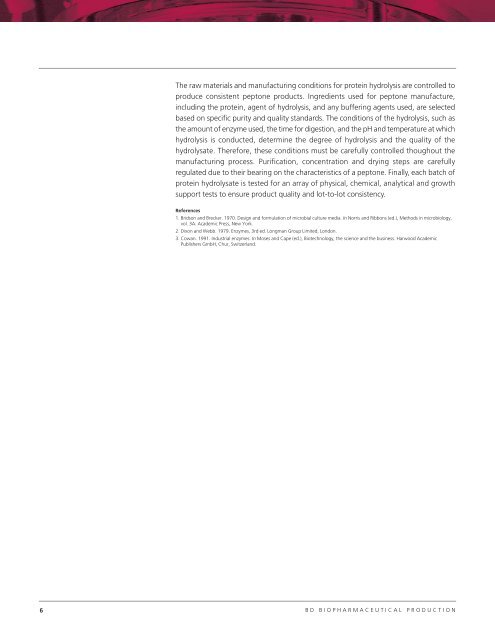BD Biopharmaceutical Production
BD Biopharmaceutical Production
BD Biopharmaceutical Production
Create successful ePaper yourself
Turn your PDF publications into a flip-book with our unique Google optimized e-Paper software.
The raw materials and manufacturing conditions for protein hydrolysis are controlled to<br />
produce consistent peptone products. Ingredients used for peptone manufacture,<br />
including the protein, agent of hydrolysis, and any buffering agents used, are selected<br />
based on specific purity and quality standards. The conditions of the hydrolysis, such as<br />
the amount of enzyme used, the time for digestion, and the pH and temperature at which<br />
hydrolysis is conducted, determine the degree of hydrolysis and the quality of the<br />
hydrolysate. Therefore, these conditions must be carefully controlled thoughout the<br />
manufacturing process. Purification, concentration and drying steps are carefully<br />
regulated due to their bearing on the characteristics of a peptone. Finally, each batch of<br />
protein hydrolysate is tested for an array of physical, chemical, analytical and growth<br />
support tests to ensure product quality and lot-to-lot consistency.<br />
References<br />
1. Bridson and Brecker. 1970. Design and formulation of microbial culture media. In Norris and Ribbons (ed.), Methods in microbiology,<br />
vol. 3A. Academic Press, New York.<br />
2. Dixon and Webb. 1979. Enzymes, 3rd ed. Longman Group Limited, London.<br />
3. Cowan. 1991. Industrial enzymes. In Moses and Cape (ed.), Biotechnology, the science and the business. Harwood Academic<br />
Publishers GmbH, Chur, Switzerland.<br />
6 <strong>BD</strong> BIOPHARMACEUTICAL PRODUCTION


